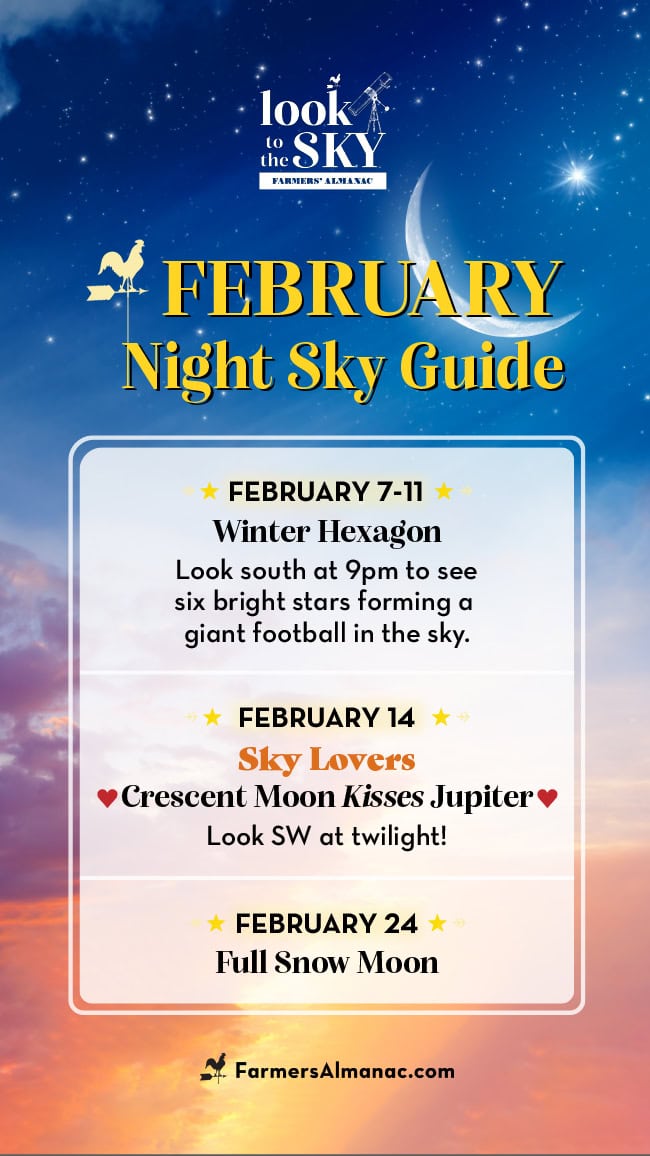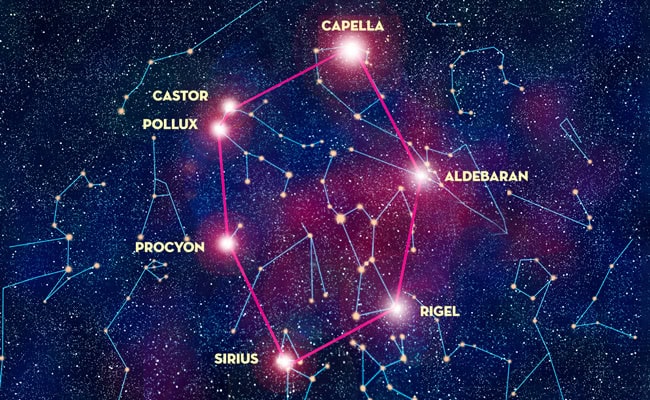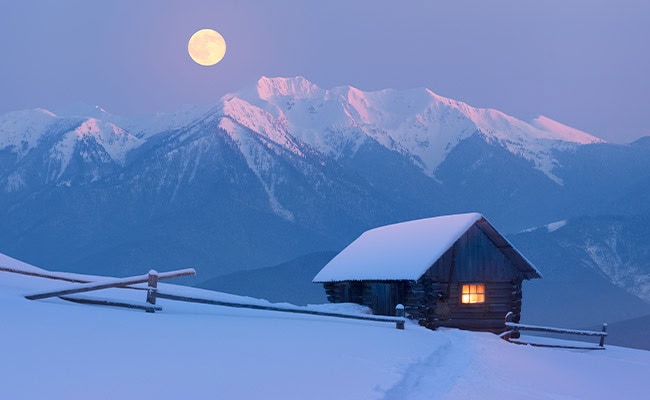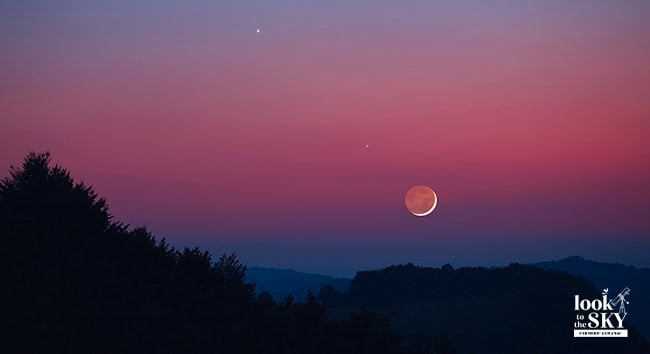February’s night sky has many highlights, including a celestial “kiss” on Valentine’s Day between Jupiter and the crescent Moon, a remarkable pairing of Venus and Mars later in the month, the Full Snow Moon, and many other bright sights! Plan your stargazing activities this month with our helpful calendar and details.
Spread the joy of stargazing with the people you care about the most! Be sure to check out our ever-expanding Starry Nights Gift Guide—it’s packed with perfect presents for night sky admirers, no matter their age or experience level!

February Night Sky Guide
Farmers’ Almanac has provided Night Sky Guides and astronomical information since 1818. and All times and positions are listed in Eastern time, 40 degrees north of the equator—unless otherwise listed. If you see the terms sunset, midnight, sunrise or “local time,” this is true no matter where you are located (no need to add or subtract for your time zone).
February 1 – Spica And The Moon
In the early hours, around midnight, look toward the east-southeast part of the sky. You’ll spot the Moon, which looks a bit smaller than usual, low in the sky, and underneath it, you’ll find a bright, blue-looking star named Spica. Spica is the shiniest star in the Virgo group of stars. As the night goes on, you’ll see the Moon move closer to Spica. They’ll look their closest to each other just before the Sun comes up, in the south-southeast sky, about one degree apart.
Also, this morning, Mercury will show up around 45 minutes before the Sun does (if you’re around 40° north latitude). But, in a few days, it will be hard to spot Mercury as it will be hidden by the Sun’s glare.
February 2 – Last Quarter Moon
The last quarter Moon occurs at 6:18 p.m. EST.
Related: Learn more about the phases of the Moon
February 7 – Venus
Venus is nearing the end of its long period of being visible in the early morning sky. At the beginning of February, it appears before the early morning light, but by the end of the month, it rises only an hour before the Sun comes up. Because of the low angle of the ecliptic (the Sun’s path across the sky) to the eastern horizon at this time for people living in the middle-northern parts of the world, Venus looks very low in the sky. Even though it’s low, Venus remains very bright at magnitude -4, and when looked at through telescopes, it shows a mostly lit-up phase that’s almost fully round.
In the morning, about 45 minutes before the Sun rises, look just above the southeast part of the sky. There you’ll see the Moon getting smaller, lit up only at 9 percent, and it will be clearly below and to the right of Venus.
⭐ February 7-11 – The Great Winter Hexagon
Around 9 p.m., look toward the south to enjoy the beautiful sight of the “Great Hexagon,” made up of bright winter stars. This star pattern is especially striking this week because there’s no bright Moon. As you look across the southern sky, you’ll spot the bright stars that form this six-sided shape.

Starting in the south, you’ll see Sirius. Moving to the west (right), you’ll come across Rigel. Climbing higher, you’ll see the reddish light of Aldebaran. At the top part of the shape is Capella. Heading south and east, you’ll find the Gemini twins, Castor and Pollux. Finally, look south again to see Procyon. Altogether, you’ll enjoy seven bright stars from six different star groups, making a wonderful pattern in the night sky.
Related: 10 Brightest Stars
February 9 – New Moon
The New Moon occurs at 5:59 p.m. EST.
Related: Why the new Moon is ideal for stargazing
Psst … we are only two new Moons away from the Total Solar Eclipse! Don’t miss this ultra rare event. Is your town in the path of totality? See total eclipse locations and regional weather for each!
February 11 – Saturn And A Crescent Moon
Up for a challenge? About 40 minutes after the Sun goes down, look towards the low west-southwest part of the sky. You’ll see a thin piece of the waxing crescent Moon (just two days after the new Moon and shining at 6 percent brightness). In the fading light of evening, it will look like the famous smile of the imaginary Cheshire Cat. Once you find it, use binoculars to search the sky roughly twelve degrees down and to the right of the Moon, to try and spot Saturn. While it’s too low for a clear view through a telescope, this last chance to see Saturn in the evening prepares us for its return in the morning sky and the amazing moment in 2025 when its rings will be seen edge-on.
(At the start of February, Saturn can be seen very low in the west-southwest sky, but as the month goes on, it moves into the bright light of the setting Sun and disappears from sight. If you want to try to see it with binoculars, tonight might be your last chance, although it won’t be easy!)
⭐ February 14 – The Crescent Moon Kisses Jupiter
On this lovely Valentine’s Day evening, look up towards the southwest as it starts to get dark. You’ll see a growing waxing crescent Moon, and as a bonus, the bright planet Jupiter will be about 5 degrees to its upper left.
At the beginning of February, Jupiter is easy to see in the southwest sky when evening falls and stays up until about 12:20 a.m. local standard time. But as the month goes on, Jupiter will start to set earlier, about 90 minutes before the night gets dark, showing the gentle and charming shifts in its position in the sky throughout February.
February 16 – First Quarter Moon
The first quarter Moon occurs at 10:01 a.m. EST.
February 22 – Mars and Venus
During the winter and continuing into much of spring, Mars, shining at a brightness of +1.3, becomes visible in the eastern sky shortly after the break of dawn. Yet it’s not very high in the sky against the light of the rising Sun, which makes it difficult to see—even with binoculars. This morning, however, offers a special chance because Venus acts as a useful guide. Venus is very close, less than one degree to the upper left of Mars, and shines much brighter than the red planet (by a remarkable difference of 120 times), giving you a clear point of reference.
Related: Visible Planets Guide

⭐ February 24 – Full Snow Moon
The Full Snow Moon reaches peak illumination at 7:30 a.m. EST.
February 28 – Mercury And Saturn “Switcheroo”
Mercury is currently on the far side of the Sun from Earth. This position is known as superior conjunction. During this time, Mercury switches from being seen in the morning sky to being seen in the evening sky.
At the same time, Saturn is lined up with the Sun, but it’s moving to be seen in the morning. This means Saturn is going from being seen at night to being seen in the early morning.
Related: Visible Planets Guide
February 29 – Leap Day
Today is Leap Day, an artifact that dates back to 46 BC when Julius Caesar took the advice of an Alexandrian astronomer. That astronomer, Sosigenes, knew from Egyptian experience that the solar year was about 365.25 days in length. So, to account for that residual quarter of a day, an extra day was added to the calendar every four years.
Unfortunately, the new Julian calendar was 11 minutes and 4 seconds longer than the actual solar year. By the year 1582, thanks to the overcompensation of observing too many leap years, the calendar had fallen out of step with the solar year by a total of 10 days. It was then that Pope Gregory XIII stepped in and, with the advice of his own astronomer, Christopher Clavius, produced our current “Gregorian” calendar.
First—to catch things up—ten days were omitted after October 4, 1582, making the next day October 15. Next, to more closely match the length of the solar year, century-years, which in the old Julian Calendar would have been leap years, were not. The exceptions were those century years equally divisible by 400. That’s why 2000 was a leap year, but 1700, 1800 and 1900 were not.
Magnitudes Explained
Magnitudes refer to the brightness of an object in space. The lower the number, the more dazzling it is. Bright stars are 1 or 0 magnitude. Fainter ones are 5 or 6. Super bright stars are in negative numbers. For instance, Sirius is magnitude -1.4. (For reference, the full Moon is -12.7 and the Sun is -26.7.)
Related Articles
Join The Discussion
What are you excited about in this February night sky?
Share with your community here in the comments below!

